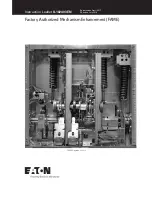
tact arm will be pulled open by the spring F. Pin C remains
nearly stationary until the contact arm is open, then it is moved
upward by the retrieving spring, S, in the closing magnet.
The other toggle is comprised of pin C, Fig. 3, and the links
on either side. In this toggle, pin C moves over center, but
it is prevented from moving further by the compressive
force present in the pull rod,
G,
w hen the closing solenoid
plunger hits the bottom of the closing magnet. T his toggle
can be closed or opened manually by inserting a maintenance
closing handle in the closing lever, E, and raising or lowering the
handle. In order to close the breaker, the armature must be
held by energizing the holding magnet coil or by means of the
locking-bar illustrated in Fig. 4. If the armature is not held, the
toggle nearest the moving contact arm will collapse and the
breaker will open.
For either type of mounting, the pole units have been com
pletely adjusted. No change of adjustment should be neces
sary and none should be made unless it is apparent that
adjustments have been disturbed during shipment.
Installation
After the breaker has been uncrated, all dust and foreign par
ticles should be wiped off with a dry cloth or vacuumed.
The polarity of the holding coil current and trip coil current
should be checked carefully to insure proper tripping of the
breaker. The
effect
of the trip coil current is
always
opposite
that of the holding coil current. However, if the breaker is
equipped with a bucking-bar-inductive shunt combination, the
holding current polarity is determined by the desired tripping
direction of current through the bucking-bar. (See Fig. 5.)
A preliminary check of the operation of the individual pole units
should be made before installation. The holding armature
should be held to the magnet surface by supplying the holding
coil with 200 milliamperes. In case holding current is not avail
able, a locking-bar for the armature may be used and is sup
plied with each order for breakers. Its use is shown in Fig. 5.
The forcing screw of the locking-bar should hold the armature
against the face of the holding magnet securely. If the arma
ture tends to pull away from the holding magnet when the
breaker is closed, then the forcing screw must be re-tightened.
However, the breaker must always be in the open position when
adjusting the forcing screw.
For closing tests, about 30 amperes at 125 V.D.C. should be
supplied to the closing coil of each pole unit tested. The cur
rent must not be applied for more than a few seconds at a time
since the closing coil is designed for intermittent duty only.
The recommended control scheme provides for a momentary
increase of the holding coil current to 400 milliamperes to in
sure positive closing.
Inspection and Maintenance
The frequency of inspection, cleaning and readjustment of con
tacts will depend on the duty to which the breaker is subjected
and the cleanliness of the surroundings. Further inspections
should be determined from accumulated operating experience
for the particular installation, although inspection periods
should not be longer than six months.
1.8. 201
Fig.
4.
Use of Locking Bar
CAUTION
All parts of the pole unit mechanism are at line poten
tial when the breaker is connected to an energized cir
cuit, regardless of whether the breaker is opened or
closed. The breaker should not be operated by hand
while connected to an energized circuit. The closing
handle, while insulated, is intended primarily for main
tenance and adjustment operations.
As a safety precaution, no work should be done on
the breaker while it is in the closed position. A
locking-bar (Fig.
5)
is provided to hold the armature on
the holding magnet for adjustment purposes when
holding current is not available. But even with the
locking-bar in place, the breaker can still open acciden
tally if the toggle adjustments have not been made
properly. Hence, it is advisable to keep fingers out of
the mechanism at all times when the breaker is closed.
Make certain that the locking-bar, tools or other loose
parts are removed before the breaker is operated or
put into service.
Avoid closing the breaker repeatedly when trips con
tinue to occur shortly after the breaker is closed. When
such conditions are encountered, the breaker unit
should be checked to determine cause. It must be re
membered that the duty imposed on the breaker pole
unit will be determined by the conditions of the par
ticular circuit application.
3
www
. ElectricalPartManuals
. com






















